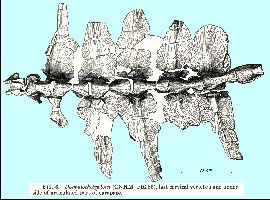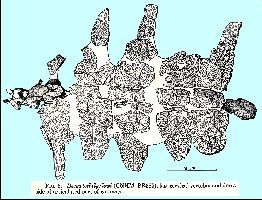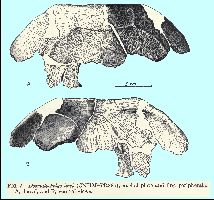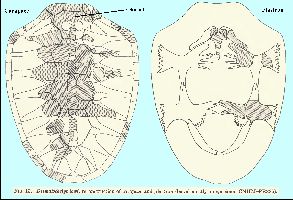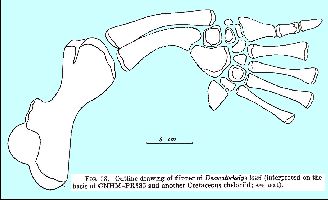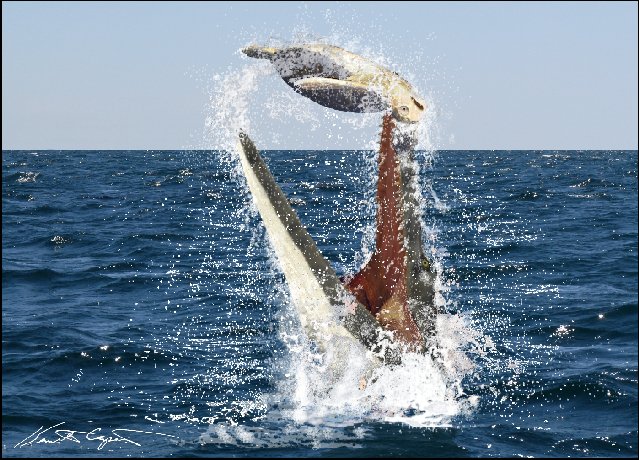 |
A New Turtle Discovery
in the Fairport Chalk,
Mitchell County, Kansas
Copyright
©2008-2013 by Mike Everhart
Page created 02/10/2008 - Last updated 05/09/2013
LEFT: Ken Carpenter's view of the pliosaur Megacephalosaurus
eulerti feeding on a marine turtle. Copyright ©
2013 by
Kenneth Carpenter Used with permission. |
The fossils of marine turtles are relatively rare occurrences in the Cretaceous
rocks of Kansas and the Midwest. They are somewhat more common further south along the
Gulf Coast. E.D. Cope was the
first to describe turtle fossils, including Protostega gigas, from the Smoky
Hill Chalk. Williston (1894) described a very unique specimen (Desmatochelys lowii
- above) from the Fairport Chalk, just north of the Kansas-Nebraska line (and re-published
the description in 1898). You can find out more about Kansas
Turtles HERE.
Although turtle remains continue to be found in Kansas rocks, occurring as early as the Kiowa Shale, they are usually fragmentary.
Williston's type specimen (KUVP 1200) was the best specimen known from the Fairport Chalk
(a slightly better one was reported from the Carlile Shale of southeastern South Dakota by
Zangerl and Sloan (1960), but it was missing most of the skull). Nicholls (1992)
reported fragmentary remains of the genus from Vancouver Island. Another specimen (MNA V4516), including a skull and limb elements, was
discovered in the Mancos Shale (Cenomanian) of northern Arizona and reported by
Elliot et al. (1997). Up until now, however, Williston's
specimen was possibly the best example of the skull of this species of marine turtle.
In early September Gail Pearson, an amateur fossil collector, was prospecting
for shark teeth in a small exposure of the middle Fairport Chalk of southern Mitchell
County when he came across a large number of bone fragments eroding from the edge of a
gully. He took photographs and sent me
pictures of what he had collected. At first, the vertebrae looked vaguely like those
of a mosasaur, but the partial humerus and other limb bones were definitely from a turtle.
I made arrangements to meet him at his home and he took me out to where the fossil was
eroding out.
Once we arrived, we could see the edges of bones exposed in a layer about half
way up the exposure. We picked up other fragments along the edges of the gully and also
some that were already re-buried below in the chalky mud. Most appeared to be pieces
of limb bones or the turtle's shell. One later turned out to be the occipital condyle of
the skull.
 |
Once we returned to the dig site, we collected more fragments from
the wash and even some that were reburied in the chalky mud below. The erosion
channel had taken off a large portion of the carapace, several limb bones and the back of
the skull. It will be interesting to see how much we were able to recover. LEFT:
This shows the initial digging done at the turtle site which removed about 16 inches of
overburden. The chalk was really damp and behaved more like clay than the chalk that I am
used to further west.. Gail had found many fragments of bone, including most of one
humerus in the gully that was cutting down through the specimen.
Once we started working back into the bone layer, we immediately found the
other humerus, broken in three pieces but otherwise complete (see picture below). It was
lying about 6 inches to left of a mound that I initially thought was the carapace. There
were fragments of the rim of the carapace lying on either side of the main concentration
of bones. |
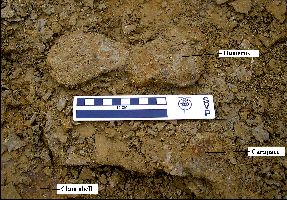 |
LEFT: A closer view of the right humerus in place, with a
partially exposed portion of the rim of the carapace at lower right, and the shell of a
clam at lower left. These shells (inoceramids) were a bit of a problem in that they looked
very much like bone and we had to stop and examine them closely as we encountered them.
They were mixed in everywhere around the bones and were layered beneath the bones.
Although the bones were in excellent condition, they were fractured and it was apparent
that the center section would need to come out in a plaster jacket. Once
we had isolated the bones to the right and left of the main concentration, we removed them
to decrease the size of the plaster and burlap jacket that we were going to use. The bones
were relatively solid and undistorted by crushing. However, because they were damp, they
were somewhat fragile. The fact that they were encased in a clay-like layer of gray chalk
helped with their removal. |
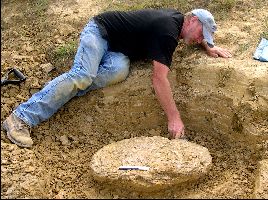 |
Here Gail is clearing the chalk matrix from the back side of the
specimen. LEFT: Once the outlying bones were removed the next task was
to trench around the specimen and create a pedestal for it in preparation for putting on
the plaster jacket. At this point, we were disappointed that we had not found the skull. |
 |
LEFT: In the process of creating the pedestal, however, I had a
chance to look more closely at the area I had initially determined was neural arches of
the carapace and realized I was looking, instead, at the skull. It was obviously crushed,
but I thought I could make out enough features to tell that it was preserved right side
up. The more I worked with it, however, the more I became convinced it was upside
down... I was partially right both times.. it had initially landed right-side up on the
sea floor, but had been crushed over to one side. .. Lying along side the skull on the
right were a number of finger bones, probably from one of the front paddles. |
 |
LEFT: At this point, we have the block of chalk containing the
bones fully prepared for jacketing... The only problem was that my Butvar and plaster were
twenty miles away in my van. I wasn't expecting this complete a specimen (very rare
in the Fairport Chalk) and hadn't come properly prepared for what needed to be done.
It was getting late, so we tarped the specimen and went back to town. The weather was a
concern (major rains were coming to Kansas ahead of Hurricane Ike). |
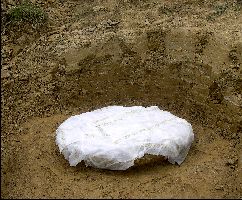 |
LEFT:Bright and early the next morning (cloudy, cool, but
thankfully still dry - but the rain was about 100 miles to the south and moving our way),
we pulled the tarp off the specimen and got to work. The first step after clearing the
working area was to pack the surface with damp paper towels. This prevents the plaster
from sticking to the bone, and helps to cushion the bone once the jacket is rolled and
while it is being transported. In some cases, aluminum foil can be used, but this specimen
was so damp that I wanted something that would help wick away some of the moisture. Note
that Charlie Sternberg also perfected the process of cleaning
off (field prepping) the bones of a specimen, building a frame around it and then pouring
plaster directly on the bones. When turned over, the remaining matrix is removed from the
bones and the specimen can be exhibited in the plaster mount. This works well for some
specimens, but also precludes the close examination of the portion of the remains that are
permanently buried in the plaster. |
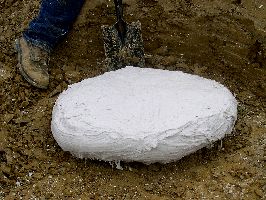 |
We mixed up about 20 pounds of plaster and water, then applied it
to strips (3-5 inches wide) of burlap and wrapped the specimen with several layers, making
sure that we went around and under the edges of the block to provide the containment
necessary when the jacket was turned over. The last thing you want is to spend a lot of
time and effort preparing to recover a specimen, and then have the matrix containing the
fossil fall out while you are turning it... it does happen! We needed a third person
to take pictures during the jacketing process since we both had plaster half way to our
elbows. LEFT: Here
Gail is cleaning up the excess plaster that we scattered around while completing the
jacket. |
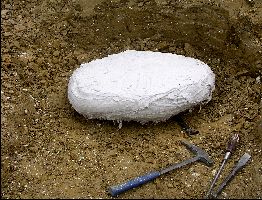 |
LEFT: As the plaster was drying (about 45 minutes) we worked at
under cutting the specimen to make it easier to roll. The chalk was very damp and almost
sticky, and did not give up easily. Finally I was able to get enough wedges underneath to
loosen it it from the pedestal. Right? Not necessarily! |
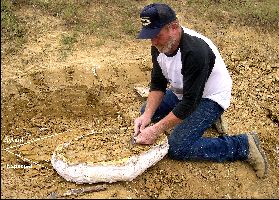 |
The "moment of truth" came and went uneventfully as we
rolled the specimen. Mother Nature being who she is, the jacket broke free about 3 inches
above where I had planned it...along a layer of thin clam shells... If I had known that,
we would have saved about 30 minutes of work. LEFT: Here Gail is
cleaning the excess chalk out of the jacket, making it lighter and easier for us to carry
to my van. While there were going to be two people loading it, there would only be one
left to unload it... Me! |
 |
LEFT: We cleaned out the jacket down to a level about 2 inches
above (below) the bones. Then we cleaned up the site and got our gear together. Note
that if the jacket was going to be stored for a long time, or transported a long distance,
we might have poured a layer of plaster into the opening to secure the specimen and
matrix. In this case, I was going to transport it about less than 200 miles and begin
removing the matrix fairly quickly. |
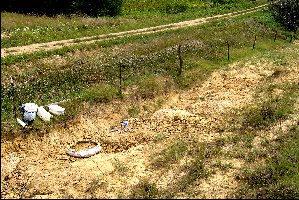 |
LEFT: This a view of the turtle locality on the south side of a
section line road where my van was parked. Not a very big exposure, but certainly an
important one. |
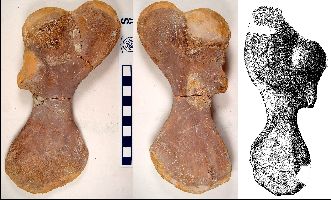 |
LEFT: Two views of the right humerus (ventral and dorsal views)
that we removed on the first day of the dig, compared with the figure of the right humerus
of the type specimen of Desmatochelys lowii published by Williston
(1894). Initially I thought they were about the same (the type specimen is about 50
percent larger (26 cm vs. 17 cm), but the more I look at it, the more I think it is
different. HERE is a
comparison between the South Dakota, the Kansas and the Nebraska specimens. The
South Dakota and Kansas specimens are nearly identical in length (17 cm) |
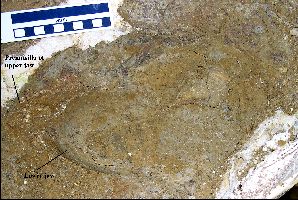 |
DAY 1 PREP LEFT: My first look at the skull as
I removed the remaining chalk from the jacket. The lower side of the lower jaw was plainly
visible, regardless of what I thought I had seen in the field. At this point there was no
doubt that the skull had initially landed right side up and then was crushed over on its
left side. |
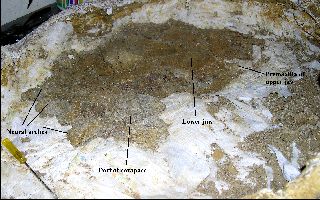 |
LEFT: Here's a picture of the specimen still in the jacket with
just about all of the chalk matrix removed. As it turned out, we had made the jacket about
twice as large as it needed to be, but in this case, too big was much preferable to too
little. I didn't want to do a lot of field prep and the large number of clam shells made
it difficult to determine where bone ended and clams began. As best I
can determine, this is the first reasonably complete turtle skull collected from the
Fairport Chalk Member of the Carlile Shale. |
DAY 3 PREP_________________(no photos from Day 2)
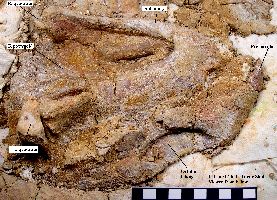 |
LEFT: A ventral view of the partially prepared skull, looking at
the lower jaw and the left side of the skull. The large orbit for the left eye is clearly
visible. |
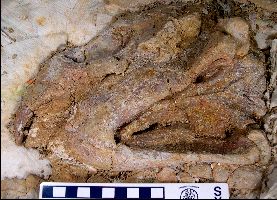 |
LEFT: Again, looking at the skull in ventral view, from the other
side for different lighting. |
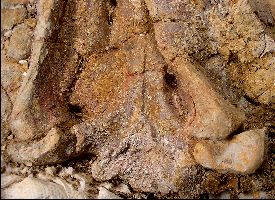 |
LEFT: The back of the palate as viewed from between the dentarys.
Large bones at left and right are the quadrates. |
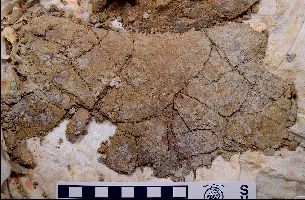 |
LEFT: After puzzling over this piece and thinking it was part of
the carapace, I finally realized it is the nuchal, a wide bone that sets across the lower
portion of the neck in the anterior part of the carapace (see Zangerl and Sloan, 1960, fig.
7 below).... in the earlier pictures there were three "lumps" along the lower
edge that I thought were dorsal vertebrae. In fact, they turned out to be just
"lumps" of chalk. This piece is relatively thin and very fragmented... not sure
just yet what I will do to preserve it. |
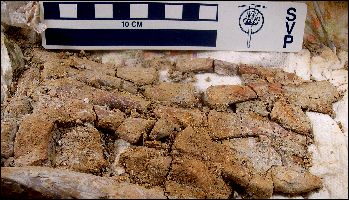 |
LEFT: Elements of one of the paddles lying on the right side of
the skull, with the "wrist" to the left side of the picture. Although all the
bones are broken, they are solid and will glue back together easily. |
DAY 4 PREP_________________
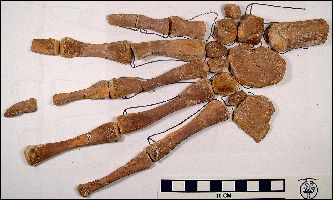 |
LEFT: This is the paddle that was laying next to the right side of
the skull... It appears that we recovered all of the bones of the wrist, but their
placement is only an estimate at this point. they were jumbled together in a pile next to
the right dentary. The shortest digit ("thumb" at top) is the only complete one
at this point. The terminal digits were eroded out prior to discovery. We probably have
most of them... but the pieces will be difficult to match up and reassemble. All of the
finger bones except one were broken at least once prior to discovery. The
bones are laid out on a copy of Fig. 18 from Zangerl and Sloan (1960- See below)...
Supposedly the same species, but there are some differences. |
 |
LEFT: Nothing too exciting here.. just several portions of the rim
of the shell. These pieces were found on both sides of the skull... Many of the marine
turtles of the Late Cretaceous, including Desmatochelys, were
"leatherbacks" in the sense that their shells and plastrons were not solid bone.
(See fig. 13 below. More than likely the shell was damaged, possibly by
a predator, before burial. |
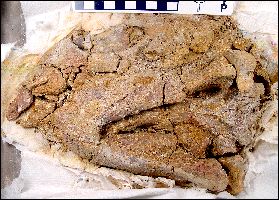 |
LEFT: The skull has been totally removed from the jacket... and
looks the worst it will ever look at this point... The pre-existing cracks have opened up
and it looks like it has been dropped. It will, however, look much better shortly.
I will begin by taking off the lower jaw, cleaning it and putting it it back
together... it should look much better the next time I photograph it. |
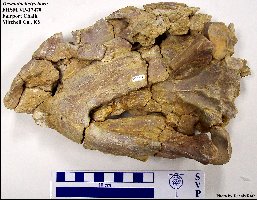 |
LEFT: (May, 2010) - Here is the ventral side of the
skull and lower jaws of FHSM VP-17470 after additional preparation and
cleaning by Dennis Roth at the Sternberg Museum of Natural History. (Photo
by Dennis Roth) |
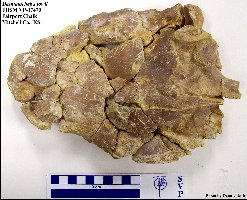 |
RIGHT: (May, 2010) - This is the first view of the
dorsal side of the skull (FHSM VP-17470) since we put the plaster and
burlap jacket on it in September, 2008 (Additional preparation and
photograph by Dennis Roth, Sternberg Museum of Natural History, Hays,
Kansas). Note that while this skull is badly crushed and not as photogenic
as the type specimen from Nebraska (KUVP
1200), it is more complete, and is certainly the best (and only) skull
of Desmatochelys lowii ever collected in Kansas. |
| Everhart,
M.J. and Pearson, G. 2009. FIRST REPORT ON A MARINE TURTLE FROM THE
FAIRPORT CHALK MEMBER OF THE CARLILE SHALE OF MITCHELL COUNTY, KANSAS. Kansas
Academy of
Science, Transactions 112(1-2):138-139.
The
type specimen of the giant protostegid turtle, Protostega gigas,
was collected by E.D. Cope from the Niobrara Chalk in 1871. Since that
time, numerous specimens of this and other turtle species have been
collected from western Kansas. Although turtle remains are known from as
far back as the Early Cretaceous (Kiowa Shale) in Kansas, specimens other
than those from the Niobrara are generally rare and usually fragmentary.
The type specimen of another protostegid turtle, Desmatochelys lowii
(KUVP 1200), was collected from the older Fairport Chalk (Late Cretaceous;
Middle Turonian) near Fairbury in south central Nebraska in 1893, but in
general the remains of turtles are rare and fragmentary in the entire
Carlile Shale Formation. In September, 2008, the authors collected the
anterior skeleton of a large marine turtle in situ from a roadside
exposure of the Fairport Chalk in Mitchell County, Kansas. The remains
consist of a complete skull and mandible, cervical vertebrae, a complete
left front limb, elements of the right front limb, and anterior portions
of the carapace, including the nuchal. The missing portion of the skeleton
suggests that the turtle was bitten by a larger predator, possibly the
pliosaur Brachauchenius lucasi. So far as can be determined, this
specimen includes the first turtle skull collected from the Fairport Chalk
in Kansas. While the specimen has been provisionally identified as Desmatochelys,
there are some differences noted between the humeri of the type as figured
by Williston (1894) and the new specimen. |
The following figures are adapted from Zangerl and Sloan (1960) in their
description of PR385, a turtle specimen from the Carlile Shale of southeastern South
Dakota:
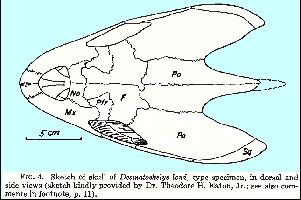 |
LEFT: Figure 4 - The skull of KUVP 1200 Desmatochelys
lowii (Note lowii is the original spelling, NOT lowi) in left
lateral and dorsal view. The figure was published in Zangerl and Sloan (1960) but actually
drawn by T.H. Eaton, Jr. from the specimen and Williston's original drawings. They
noted on page 12: Dr. Theodore H. Eaton, Jr., has kindly examined the skull of the
type specimen of Desmatochelys lowi and has
rendered drawings (fig. 4). We wish to express our sincere gratitude to Dr. Eaton for his
meticulous re-examination; with his kind permission we quote from his account: “The
dorsal view is traced over Williston's (1894) pl. II, which is mainly correct except for
minor differences in the sutures (esp. prefrontal) and the length of the occipital spine.
His palatal view (pi. Ill) I have not redrawn; it is correct as far as it goes, but there
is in addition a median suture separating the pterygoids as well as the palatines, and the
vomer comes back to a point almost half the distance between the choanae and the
transverse suture. With more preparation the posterior part of the cranium would give many
details of value, although a
hole 1/2 inch in diameter has been drilled vertically up into the basicranial region.
The actual length of the skull to the point where the occipital spine is broken off is 215
mm., not 205, and its probable length when complete would be about 240. The scale of figs.
II and III is approximately 3/4 rather than 2/3.” |
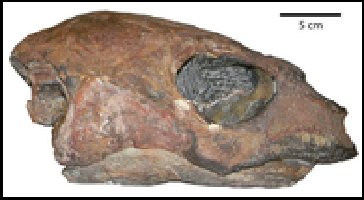 |
LEFT: The skull of 'Desmatochelys' sp. (UCMP
38346) collected from the Early Cretaceous near Bogota, Columbia, South
America.
RIGHT: The skull of UCMP 38346 in dorsal view.
Gaffney et al. (2007) noted that: “The University of California has a skull and partial
skeleton (UCMP 38346) of an undescribed chelonioid from the vicinity of
Bogota, Colombia (V 4538), that may be Aptian-Barremian in age (Welles,
1962) … However, this material has never been described and its age is
not substantiated.” |
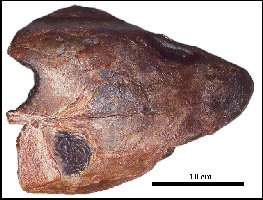 |
REFERENCES:
Cope, E.D. 1871. A Description of the genus Protostega,
a form of extinct Testudinata
. Proceedings of the American Philosophical Society 12(86):422-433.
Cope, E. D., 1872. On the
geology and paleontology of the Cretaceous strata of Kansas. Preliminary Report of the
United States Geological Survey of Montana and Portions of the Adjacent Territories, Part
III - Paleontology, pp. 318-349.
Elliott, D.K., Irby, G.V. and Hutchinson, J.H.
1997. Desmatochelys lowi, a marine turtle from the Upper Cretaceous. pp.
243-258 in Callaway, J.M. and Nicholls, E.L. (eds.). Ancient Marine Reptiles,
Academic Press, San Diego.
Everhart, M.J. and Pearson, G. 2008. First report on a marine turtle from the Fairport
Chalk Member of the Carlile Shale of Mitchell County, Kansas. Kansas Academy of Science, Transactions 112(1-2):138-139 (Abstract).
Gaffney,
E. S. 1972. An
illustrated glossary of turtle skull nomenclature. American
Museum Novitates 2486:1-33.
Gaffney, E.S., Rich, T. H.V., Rich,
P.V., Constantine, A.E., Vacca, R. and Kool, L. 2007. Chubutemys,
a new eucryptodiran turtle from the early Cretaceous of Argentina, and the
relationships of the Meiolaniidae. American Museum Novitates 3599, 35
pp., 14 figs., 2 tables.
Nicholls, E.L. 1992. Note on the
occurrence of the marine turtle Desmatochelys (Reptilia: Chelonioidea)
from the Upper Cretaceous of Vancouver Island. Canadian
Journal of Earth Sciences 29:377-380.
Roth, D.D. and Everhart, M.J. 2012. Preparation
of a protostegid turtle from the Fairport Chalk (Carlile Formation, Late
Cretaceous). Kansas Academy of Science, Transactions 115(1-2):71-72.
Schumacher, B.A., Carpenter, K. and
Everhart, M.J. 2013. A new Cretaceous Pliosaurid (Reptilia, Plesiosauria) from
the Carlile Shale (middle Turonian) of Russell County, Kansas, Journal of
Vertebrate Paleontology 33(3):613-628.
Williston, S.W. 1894. A new turtle from the Benton Cretaceous. Kansas. University
Quarterly 3(1):5-18, pls. II-VI.
Williston, S. W. 1898. Turtles. The University Geological Survey of Kansas, Part
VI. 4:349-369. pls. 73-78.
Zangerl, R. and R. E. Sloan. 1960. A new description of Desmatochelys lowi
(Williston). A primitive cheloniid sea turtle from the Cretaceous of South Dakota.
Fieldiana, Geology Memoirs 14:7-40.



























